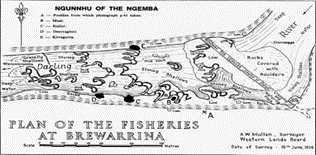
Posted by : Holly Randell-Moon May 5, 2022
Contact : randell-moon at csu.edu.au Maps
In this chapter we outline how an understanding of pre-invasion Indigenous engineering can contribute to teaching and delivery of science, technology, engineering, and mathematics (STEM) materials in high schools and universities. A growing body of work argues that effective STEM delivery should engage with First Nations communities, their epistemologies (ways of knowing), and their aspirations. Rather than attempt to align Indigenous science with dominant western knowledge (where the two systems are competing), a third knowledge space can be created in between these two knowledge systems. This chapter shows how to create a cross-cultural space – a middle-ground – between western and traditional Indigenous knowledge domains by examining Indigenous engineering principles of automation in the Brewarrina fish and Budj Bim eel systems. This cross-cultural space can be achieved through the Mutual Cultural Responsivity framework. Despite principles of automation underpinning the design and operation of many Indigenous agricultural and aquacultural practices, contemporary engineering and technological debates regarding automation exclude Indigenous perspectives. The eel systems at Budj Bim are a vast aquaculture network designed by Gunditjmara peoples to manage and automate the flow of eels and fish. The Brewarrina fish traps, devised by the Ngemba peoples, are estimated to be one of the oldest human technologies and like the eel traps, worked to automate fish farming. The purpose of the chapter shows how western and Indigenous knowledges can be productively bought into a cross-cultural space and effectively taught together in STEM education. These case studies’ use of automation are an impactful way of connecting Indigenous engineering practices to contemporary STEM debates about technology and sustainability. Our lesson plans engage students through intergenerational learning and demonstrate Indigenous science and engineering as an ongoing and lived practice.
Extract from Chapter 7, Indigenous Engineering for an Enduring Culture, edited by Cat Kutay, Elyssebeth Leigh, Juliana Kaya Prpic and Lyndon Ormond-Parker. Published by Cambridge Scholars Publishing
Author: Nicholas Ruddell and Holly Randell-Moon
Location: Charles Stuart University